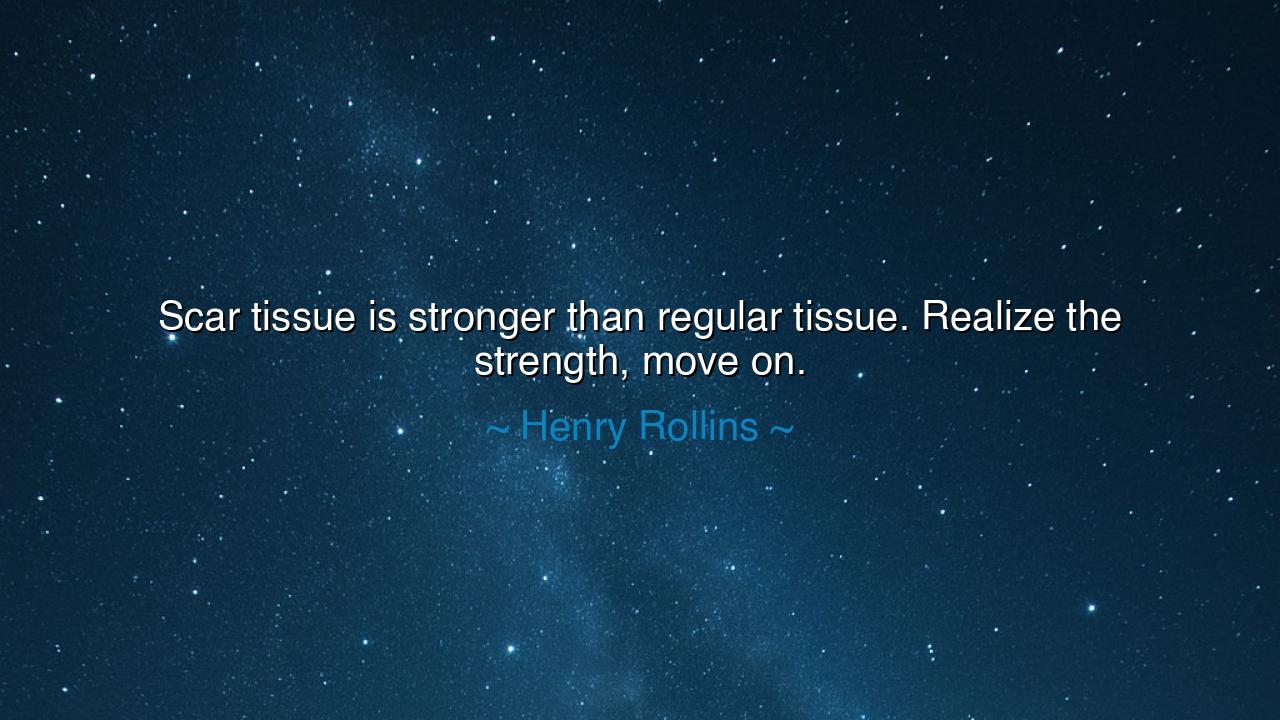
Scar tissue is stronger than regular tissue. Realize the






Henry Rollins, the fierce voice of defiance and endurance, once declared: “Scar tissue is stronger than regular tissue. Realize the strength, move on.” In these words is woven a truth both bodily and spiritual. For when the flesh is torn, it heals not into weakness but into resilience; the scar that forms is thicker, tougher, more enduring than what was there before. And so it is with the human heart and soul: each wound, once endured and mended, becomes a source of hidden strength. Pain is not the end but the forge in which endurance is hammered.
The ancients knew this law of the body and spirit alike. In the tale of Odysseus, he returned from his wanderings scarred and battered, yet it was those very scars that proved his identity to those who doubted him. The Spartans taught their warriors that the marks of battle were badges of honor, proof that strength is not found in untouched skin but in wounds endured and overcome. Rollins, in the modern tongue, gives voice to the same ancient wisdom: scars do not mark weakness—they proclaim survival.
History too bears witness to this truth. Consider the life of Abraham Lincoln. He suffered failures in business, defeat in politics, and crushing personal losses, including the death of his beloved son. These wounds carved deep into his spirit, yet from them grew a resilience and compassion that later carried a divided nation through its darkest trial. His “scar tissue” was not shame but strength, making him the leader the hour required. Without scars, he would not have had the fortitude to endure the Civil War’s endless storms.
Or think of Helen Keller, struck blind and deaf in childhood. Many might have remained imprisoned in silence and despair, yet she transformed her suffering into strength. Every frustration, every wound of isolation, became scar tissue that carried her forward. By her endurance, she became a teacher to the world, proving that what is scarred may also become unbreakable. The wound, once healed, becomes a pillar of strength.
But Rollins does not stop at recognition of scars—he commands us to act: “Realize the strength, move on.” Too many dwell endlessly on their wounds, replaying them as sources of pity or despair. Yet the scar is not a prison, it is a reminder that healing has already taken place. To move on is to refuse to let the memory of pain dictate the future. The scar says: “I was broken, but I am whole again, and stronger than before.”
This wisdom is deeply motivational. It teaches us that life will wound us—no soul escapes untouched. But the wound is not the end. To be scarred is to be seasoned, to be tested, to be remade into something tougher. Those who have known suffering and risen again possess a depth and resilience unknown to the untested. The scar is a silent medal of honor, proof that you have endured and triumphed.
The lesson is clear: Do not despise your scars, whether of flesh or spirit. Honor them as signs of strength. See in them the evidence that you were struck down but did not stay down. And above all, do not live forever in the shadow of pain. Move on. Take the strength your scars have given you and walk boldly into the future, carrying resilience as your armor.
Practical action flows from this: reflect on your wounds not with bitterness, but with gratitude for the strength they have forged in you. When new trials come, remind yourself that you have endured before, and you are stronger now. Encourage others who suffer, pointing to your own scars as proof that healing is possible. In this way, you will live the wisdom of Henry Rollins: scar tissue is stronger than regular tissue—and when you realize this, you will never again be defined by wounds, but by the strength they left behind.






AAdministratorAdministrator
Welcome, honored guests. Please leave a comment, we will respond soon